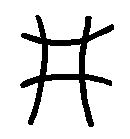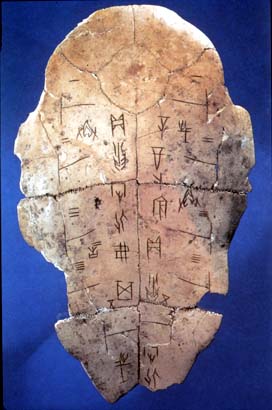![]()
f. vercnocke
When on
my journey
I was thirsty
you gave me
strength
when I
was looking
for a way
out of this
desert
you gave me
the key
when I
at night
was searching
in the sky
for a new light
you gave
a million torches
and so,
peacefully,
I went
to sleep
b. vercnocke

I am a tree
and caressed
sometimes
I bend
O, no,
I wonít
resist
O, and when
I break
Iíll sink
Iíll sink
into your womb
and stronger
I will grow
b. vercnocke
The I Ching is an ancient Chinese book of wisdom and divination. Some 3000 years ago, it sprung out of an oral tradition and through centuries of editing, was written down. It is a "holy" book, in importance to be compared with the Bible, the Koran, the Thora or other spiritual, philosophical and religious classical texts. Its title usually is tanslated as:"The Book Of Changes", "The Classic of Changes", or "Changes of the Zhou (Zouyi)".
Here is what
Thomas Cleary, a famous translator of Chinese texts
writes on the book in the introduction of his translation: "It has
been considered the deepest and most difficult of all the classics. Even so,
it has been used as a standard resource for more than twenty-five centuries
in business, politics, and warfare, as well as in education, culture and
religion. Because of the wide range of analogy its interpretation can
support, the Book of Changes is drawn on for advice in both personal
and professional matters. In this way, over the ages it has become a popular
oracle of ancient wisdom.
According to traditional scholars of the Chinese classics, the title of this
book, Change, essentially implies adaptation. The underlying question
the Book of Changes addresses is how to respond to change - in
ourselves, in our relationships, and in the world at large. The reason the
book can be interpreted in so many ways is because the words, images and
statements are couched in several layers of archaic language, admitting of
various literal and symbolic readings Using this
flexibility, readings are adapted to the context under consideration by
metaphor and analogy."
One can look at the I Ching as a wise counsellor, who is always there for you, yet will never force you to make a decision, on the contrary. When asked for advice, the answer will always offer you the freedom of conduct. The book often offers you a mirror, when one realizes you always had the answer in you. Thus, the method can be compared with the teachings of Socrates and the book becomes a sort of midwife. In learning how to get a question right, one is, almost uncounciously, directed to the answer ("aha-erlebnis").
Consulting the book
is based on a coincidental ritual: tossing of coins, drawing of cards,
counting and shifting of yarrow sticks, etc. Depending on the outcome, the I
Ching gives advice through one of its 64 judgements (see example on the
right). The judgement is linked to a 6-line pattern of yin (![]() )
or yang (
)
or yang (![]() ) lines. That's why the pattern
is called "hexagram". Moreover, each lines has a seperate advice. In this
way the book counts 64 x 6 = 384 line texts. It's remarkable that all
possible situations that give rise to advice , even nowadays, are covered by
such a limited range of judgements. Remarkable, but not sursprising.
Thousands of years ago, questions and answers were marked in tortoise
shields or cattle bones and then heated. The cracks, originating from the
heating, led the way to the outcome. Now, only a fraction of the millions of
bones and shields are dug up. So, through the centuries, a lot of questions
came up, but the shaman found out that the advice could be compiled in
only a few standard judgments, because often the same answers popped
up. Eventually, through a very secure process of filtering, the 64
judgements came into being. So one can be assured that these judgements are
firmly "grounded" (see also
Javary/Faure).
) lines. That's why the pattern
is called "hexagram". Moreover, each lines has a seperate advice. In this
way the book counts 64 x 6 = 384 line texts. It's remarkable that all
possible situations that give rise to advice , even nowadays, are covered by
such a limited range of judgements. Remarkable, but not sursprising.
Thousands of years ago, questions and answers were marked in tortoise
shields or cattle bones and then heated. The cracks, originating from the
heating, led the way to the outcome. Now, only a fraction of the millions of
bones and shields are dug up. So, through the centuries, a lot of questions
came up, but the shaman found out that the advice could be compiled in
only a few standard judgments, because often the same answers popped
up. Eventually, through a very secure process of filtering, the 64
judgements came into being. So one can be assured that these judgements are
firmly "grounded" (see also
Javary/Faure).
The ideogram for Ching : 經 (see also on the right) means: standard, loom, channel. Together with I (= change, manoeuvrability, sun coming out behind the clouds) one could think of the I Ching as a loom that, through its warp and weft, shows the pattern of one's Tao. Since the I Ching shows this pattern in a mere coincidental way, it is inviting to explore the ways of synchronicity.
After all, coincidence is no more than the sudden illumination of the contact between oneself and Tao (cfr. Indra's Net"): in the loom of the universe we touch and are touched by it. In the universe of the I Ching this surrendering to coincidence is not "a subjecting to fate", but the positioning of the Self in a context. Coincidence makes one aware of the cosmic unity, of the enternal NOW, where everything is born and fades away. This proces is not fatalistic, on the contrary: it is a constant challenge to apply and experience the peace and quiet of this cosmic happening in our daily life. That's our choice and responsibility. This demands an openess of mind and daring to continue in trust and confidence, beyond our fears. This also implies that paradoxical thinking (e.g.: good/bad - black/white - love/hate -life/death -left/right etc.) only is our own creation. Where thinking ends, or is unleashed, the answer is born (cfr. Lao Tze, Tao Te Ching), as natural as we were ourselves before and just after our birth.
A lot of background
information can be found at
LiSe Heyboer's wonderful site.
"The Well"
ideogram:


hexagram:
Judgement:
"One might change a city, but one does not change a Well. It neither loses nor gains. People may come and go, but it remains the same Well. And if one breaks the pot, there will be misfortune."
(Wang Bi)

Tortoise shield
with inscriptions
I:
![]()
change
CHING:

standard, channel
l. Nilsson